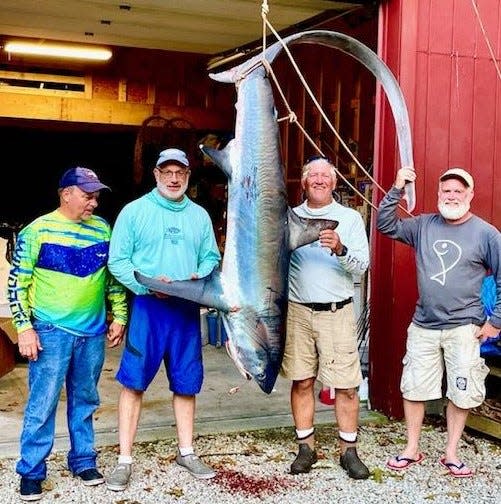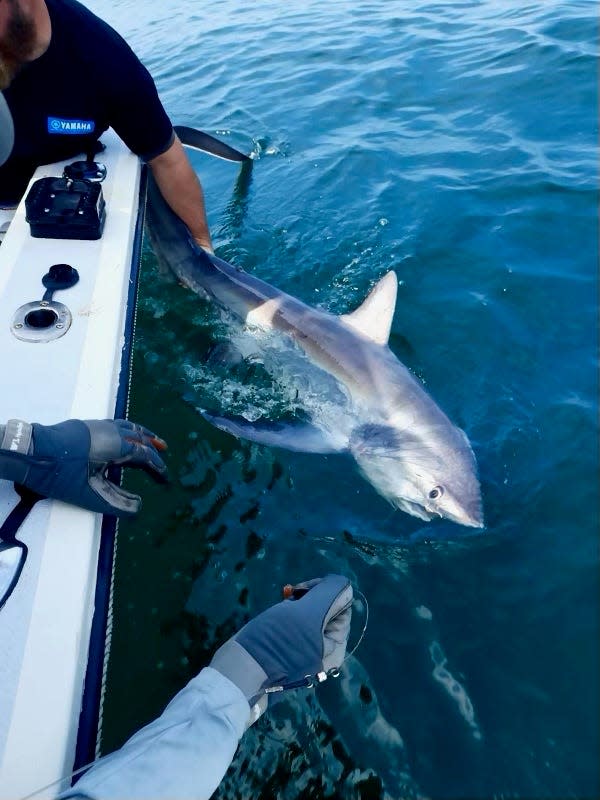How close have you been to a shark? This Tiverton man caught one off Newport
“When the shark surfaced, its tail slapped the water into a froth a few times,” said Greg Vespe, former Rhode Island Saltwater Anglers Association executive director, who is in awe of thresher sharks.
This is the second thresher he has caught this year on his 19-foot center console that he custom-built. Vespe, of Tiverton, caught a couple of threshers last year also — one was 325 pounds and 11 feet, 4 inches long.
“These fish are majestic," he said. "Just so beautiful. They do not normally come up to your boat like other sharks do when fishing. So, to see them up close, you have to catch one. And each one is different. The fish we caught this week was down deep and it stayed down for the first 15 minutes. Then it leaped into the air clear out of the water."

All of the thresher sharks caught by Vespe came from the same general location — Southeast of Newport and the mouth of the Sakonnet River in sight of land.
“We caught and successfully released this fish due to the good work of the crew," Vespe said. "My father, Ric Vespe, was at the helm; my son, Shawn Hayes Costello, and cousin Stephano Leoni, here visiting from Italy, were on the reel. They did a great job."
Angling for any fish can be dangerous, particularly sharks. Anglers should be fully trained on how to catch, handle and release these fish once they get to the boat. Recreational fishermen must have an Atlantic HMS permit to harvest Atlantic common thresher sharks in federal waters. To receive a shark endorsement on that permit, anglers must watch a shark identification video and pass a brief online test.
“What you must be careful of is getting bitten — after all, it is a shark," Vespe said. "But what you really must watch is the thresher’s tail [they are also known as whiptail sharks]. They use their tail as a weapon to stun prey. When the shark we caught last week came to the boat, it whacked the engine housing with its tail; if that tail swung higher, it could have cleared anyone on the stern right off the boat.”

Vespe has a couple of thresher fishing tips. “First, I prefer smaller, 1- to 2-pound baits. Butterflied mackerel and jumbo squid work well. And I tend to chum less than most. I don’t think chum brings in threshers like most sharks; they just have to kind of find your bait.”
And, according to Vespe, “Threshers are delicious and taste very much like swordfish. Needless to say, my family eats well when we catch and decide to keep a thresher.”
Many sharks in our area are not legal to catch as they are overfished. This is not the case with thresher sharks. According to the National Atmospheric and Oceanic Administration (NOAA), “U.S. wild-caught Atlantic common thresher shark is a smart seafood choice because it is sustainably managed and responsibly harvested under U.S. regulations.”
Congratulations, Greg and crew, and thanks for the great fish story.
Where’s the bite?
Striped bass and bluefish. “Bluefish have followed large schools of scup into the upper reaches of the Bay with a modest striped bass bite. The skipjack bluefish bite has been strong in estuaries,” said Dave Henault of Ocean State Tackle in Providence. Declan O’Donnell of Breachway Bait & Tackle in Charlestown reported: “Bass fishing has been very good both out in front of South County Beaches and in the salt ponds. Fish are chasing a variety of bait. Bluefish are around, too, and as temperatures continue to drop, more will filter in.” Fred DeFinis of Tiverton, said, “A mix of school bass and bluefish were in the lower Sakonnet River this week; feeding on very small silversides — barely over an inch long. Smallest bait I have ever seen. My guess is that the striped bass are just vacuuming them up so they are very fussy.”
Tautog. Angler Paul Boutiette reports: “This weekend off Point Judith, Narragansett, in 40 feet of water, we let out 20 feet more anchor roap and my bride caught the first keeper at 17. Finally, I caught a keeper tog. It was great to be catching tog again, and they are around,” O’Donnell said. “Tautog bite from shore has been great. Not too many people targeting from boats yet.”
“The tautog bite is good in the lower Bay in 20 to 40 feet of water off Narragansett, Tiverton and Jamestown,” Henault said.
Fluke, black sea bass and scup. “Fluke fishing has been slow but lots of seabass being caught with some nice sized ones in the mix,"O'Donnell said. “We have a very strong scup bite in Narragansett Bay with the black sea bass and summer flounder [fluke] bite improving,” Henault said.
Offshore. “Tuna reports are still solid," O'Donnell said. "Both yellowfin and bluefin can be found relatively close. Even reports of a 7- pound bluefin caught a mile from shore chasing mackerel. Always carry a bigger rod in your boat this time of year — never know what you might run into."
Freshwater fishing continues to improve as things have cooled off a bit. “Shiners continue to produce for largemouth bass customers,” Henault said.
Dave Monti holds a captain’s master license and charter fishing license. He serves on a variety of boards and commissions and has a consulting business that focuses on clean oceans, habitat preservation, conservation, renewable energy and fisheries-related issues and clients. Forward fishing news and photos to dmontifish@verizon.net or visit www.noflukefishing.com.
This article originally appeared on The Providence Journal: Fishing Report: Tiverton man hauls in thresher shark off Newport
